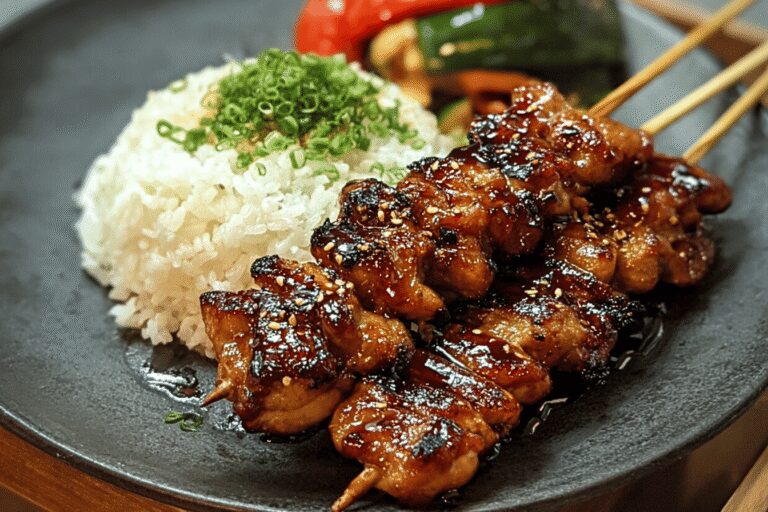Japanese Pork Curry Recipe
Introduction
If you’re a fan of hearty, cozy meals that deliver on both flavor and comfort, Japanese pork curry is a dish you must try. Packed with tender pieces of pork, velvety sauce, and infused with the subtle sweetness and spice synonymous with Japanese curry, this recipe is a delight for the taste buds. Perfect for a weekend dinner or meal prep for the week, this curry is satisfying and easy to make.
Detailed Ingredients with Measures
pork shoulder or belly, cut into bite-sized pieces
onions, finely chopped
carrots, peeled and sliced into rounds
potatoes, peeled and cut into chunks
garlic cloves, minced
ginger, grated
Japanese curry roux blocks
water
vegetable oil
soy sauce
honey
salt, to taste
cooked white rice, to serve
TIP:
Japanese curry roux blocks are a key ingredient that can be purchased at most Asian grocery stores. Make sure to select mild, medium, or hot depending on your spice preference.
Prep Time
The preparation for this recipe is straightforward and manageable for any home cook. Set aside approximately 10-15 minutes to cut the ingredients, mince the aromatics, and prepare your workspace. This makes the cooking process smooth and enjoyable.
Cook Time, Total Time, Yield
Cook Time: Around 1 hour – This includes simmering the curry to ensure the tenderness of the pork and the melding of flavors
Total Time: Approximately 1 hour 15 minutes
Yield: Serves 4 – Generous portions that are perfect for a family meal or meal prep
Japanese pork curry is a wonderful way to explore the delicious world of Japanese cuisine, all from the comfort of your own kitchen. The mix of tender pork, vegetables, and curry sauce served over rice offers a hearty and comforting meal for any occasion. Enjoy this flavorful dish today!
Detailed Directions and Instructions
Step 1: Prepare the Ingredients
– Finely dice the onion, carrot, apple, and garlic.
– Slice the pork into bite-sized pieces and season with salt and black pepper.
Step 2: Sauté the Pork
– Heat a large pot or Dutch oven over medium-high heat and add a drizzle of oil.
– Once the oil is hot, add the pork pieces in batches, searing them until browned on all sides. Avoid overcrowding the pot.
– Remove the seared pork from the pot and set it aside.
Step 3: Sauté Aromatics and Vegetables
– In the same pot, add a bit more oil if necessary.
– Add the diced onions, and sauté them over medium heat until softened and translucent.
– Add the diced carrots, and stir everything together for 2-3 minutes.
– Add the finely diced apple and garlic, and cook for another 2 minutes until fragrant.
Step 4: Add Curry Powder and Flour
– Sprinkle the curry powder and flour evenly over the sautéed ingredients.
– Stir continuously for 2-3 minutes to toast the spices and cook the raw flavor out of the flour.
Step 5: Add the Broth and Bring to a Simmer
– Slowly pour in the chicken or pork broth while stirring the mixture to prevent lumps from forming.
– Add the bay leaves, soy sauce, and Worcestershire sauce.
– Stir everything well to combine.
Step 6: Add the Pork Back to the Pot
– Return the seared pork pieces to the pot, along with any juices that collected on the plate.
– Reduce the heat to low, cover the pot with a lid, and let the curry simmer gently for about 45 minutes.
– Stir occasionally to ensure nothing sticks to the bottom.
Step 7: Adjust the Consistency
– After 45 minutes, check the consistency of the curry. If it is too thick, add a splash of warm water or broth to loosen it to your desired thickness.
Step 8: Final Seasoning
– Taste the curry, and adjust the seasoning with additional salt, soy sauce, or Worcestershire sauce as needed.
Step 9: Serve
– Serve the Japanese pork curry hot over steamed white rice.
– Optionally, garnish with thinly sliced green onions or freshly chopped parsley for added flavor and presentation.
Notes
Note 1: Apple Sweetness
Using a sweet apple like Fuji or Gala helps balance the savory spices, but a tart apple like Granny Smith can also be used for a slightly tangy flavor.
Note 2: Cutting the Pork
Make sure to cut the pork into even-sized pieces to ensure they cook evenly.
Note 3: Curry Powder
Use a Japanese-style curry powder for an authentic flavor. Adjust the amount to your heat and flavor preference.
Note 4: Leftovers
The curry tastes even better the next day as the flavors deepen. Store leftovers in an airtight container in the refrigerator for up to 3 days.
Note 5: Thickening the Curry
If you prefer a thicker curry, let it simmer uncovered for the last 10-15 minutes of cooking.
Note 6: Vegetarian Substitute
For a vegetarian version, you can replace the pork with tofu or additional vegetables like potatoes and mushrooms, and use vegetable broth instead.
Note 7: Rice Pairing
Short-grain Japanese rice pairs best with this curry. Be sure to rinse the rice thoroughly before cooking.
Cook Techniques
How to Cook the Pork Properly
Be sure to cut the pork shoulder into smaller pieces so that it braises properly. Searing the pork beforehand is important, as it locks in the flavors and provides a good base for the dish.
Building Flavor with the Curry Roux
Adding the curry roux toward the end allows the rich flavors to meld without burning. Let the curry simmer to ensure the roux dissolves fully and thickens the sauce.
Importance of Low and Slow Cooking
Cooking the dish on low heat over time enhances the tenderness of the pork and allows all the spices, aromatics, and broth to combine, creating a balanced flavor profile.
Choosing the Right Vegetables
Use vegetables like potatoes and carrots that hold up well under stewing. Cut them into even chunks to ensure consistent cooking. This avoids overly mushy vegetables.
Simmering for Optimal Flavor
Slow simmering on low heat not only softens the vegetables but also lets the flavors meld together. Stir occasionally to prevent the mixture from sticking to the pot.
FAQ
Can I use a different cut of pork for this recipe?
Yes, you can substitute pork shoulder with pork belly or even pork loin. Keep in mind that leaner cuts like pork loin might not be as tender after slow cooking.
What kind of curry roux should I use?
You can use store-bought Japanese curry roux for convenience. These come in mild, medium, and hot, so choose one based on your spice preference.
Can I make this dish vegetarian?
Yes, you can substitute the pork with tofu or skip it altogether and rely on the vegetables to create a delicious curry. Use vegetable stock instead of chicken stock for the base.
Can I prepare this recipe ahead of time?
Certainly! This curry tastes even better the next day as the flavors develop and meld together. Store it in an airtight container in the refrigerator and reheat before serving.
What can I serve with this Japanese Pork Curry?
Japanese pork curry is traditionally served with steamed white rice. You can also enjoy it with brown rice or over noodles for variety.
How do I store leftovers?
Leftovers can be stored in an airtight container in the refrigerator for up to 3 days. Reheat in a pot on the stove or microwave before eating.
Can I freeze Japanese Pork Curry?
Yes, you can freeze the curry in portions for up to 2 months. Make sure to thaw it in the refrigerator before reheating. Avoid freezing if you’ve used potatoes, as they may become mushy.

Conclusion
Japanese Pork Curry is a comforting and delicious dish that combines tender pork with a rich, flavorful curry sauce. It’s perfect for a cozy dinner and is guaranteed to be a hit with family and friends. The beauty of this recipe lies in its adaptability – you can adjust the heat level, customize the vegetables, or even swap the pork for another protein to suit your preferences. Give it a try and enjoy the warmth and heartiness this dish brings to your table.
More recipes suggestions and combination
Japanese Chicken Katsu Curry
If you love curry but want a different protein, consider making a Chicken Katsu Curry. The crispy chicken cutlet pairs beautifully with Japanese curry sauce.
Vegetarian Japanese Curry
For a vegetarian twist, replace the pork with hearty vegetables like sweet potatoes, mushrooms, and cauliflower.
Japanese Beef Curry
Switch up the meat and try beef as the main protein. Slow cook it for a tender and satisfying dish.
Seafood Japanese Curry
Add a mixture of shrimp, scallops, or even crab to create an exciting seafood version of Japanese curry.
Homemade Curry Buns
Use leftover curry as a filling for soft, fluffy bread to create Japanese curry buns, which make for a perfect snack or lunch.
Curry Over Udon
Pair your curry with udon noodles instead of rice for a comforting and filling curry udon bowl.
Japanese Curry Fried Rice
Transform any leftover curry into a delicious fried rice dish by mixing it with cooked rice and your choice of vegetables.







